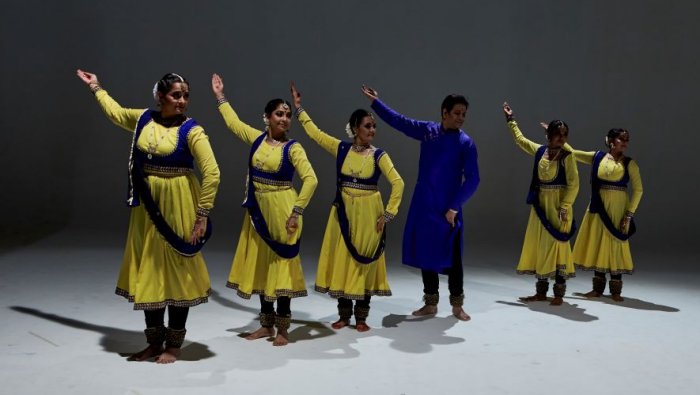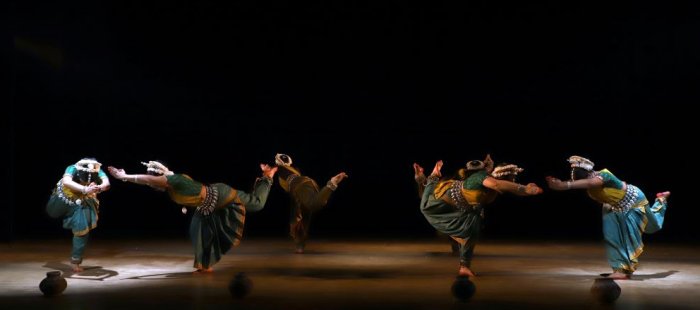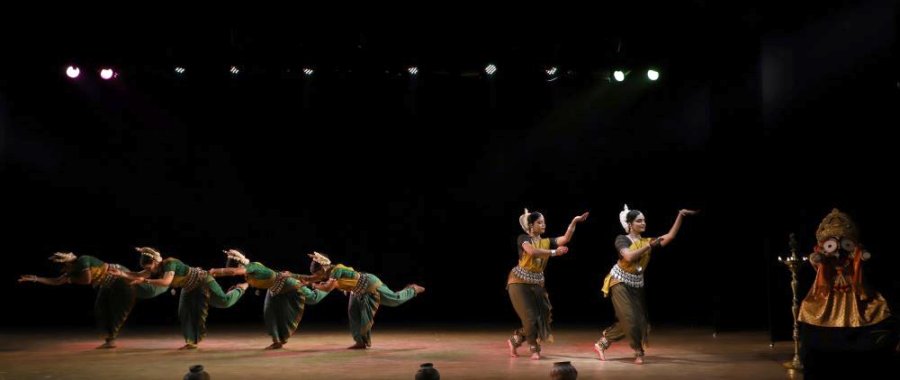
|   |

|   |
 e-mail: leelakaverivenkat@gmail.com Navarasa - A Virtual Dance Festival June 22, 2023 Kathak aesthetics in a virtual festival Conceived by Ashish Khokar of Attendance, Navarasa-A Virtual Dance Festival under the aegis of Delhi's Habitat Centre, began with a Kathak presentation by Nadam of Bangalore, run by Nandini K Mehta and K. Murali Mohan Kalva - the aesthetics of the performance showing a happy blend of tradition and eclecticism. Starting from a Bharatanatyam background before specializing in Kathak from the Natya Institute, Nandini, along with Jaipur gharana trained Murali Mohan Kalvakalva with whom she teamed up, have guided Nadam Ensemble pioneered in 1994. What one noticed in the Habitat presentation, was the combined effect of choreographic elegance executed by excellently trained students, based on a take-off point of musical excellence, which seemed to draw on influences both from the north and the south of the country.  Murali Mohan Kalvakalva and Nandini Mehta The excellently pronounced Sanskrit terminology of the musical compositions by vocalist Faiyaz Khan (not always evident in Kathak musicians even while rendering oft used compositions of prayer in Sanskrit), began with an invocation on Ganapati "Mahaganapatim" (composition by Muthuswamy Dikshitar in raga Nata, with a prolific presence in Carnatic classical) set in this case, to raga Jog in teental by Praveen Rao - the recitational start going on to melody composed to suit the Kathak matrix. The many images and epithets of Mahakavya nataka priyam, Modaka priyam, guruguhanutam, marakoti prakasham shantam, were suggested in the dance language through various hand gestures and attitudes, the accent being more on peppy rhythmic arrangements by the coordinate group. Unlike the fulsome Krishna images in Kathak, this recital was Shiva oriented. Nataraja Kshitiraja, the next item, with just two dancers Murali Mohan and Nandini, was based on the Jata joota dancing Shiva, the short sahitya passages punctuated by Dha ta ka thunga adforms, and nritta virtuosity with peir ka kaam. With their Dharwad background, Karnataka people often have a special closeness to both Hindustani and Carnatic classical music. The music by Praveen Godkhindi for the pure dance oriented Dhamar composition, saw four female dancers turned out in an aesthetic red getup, perform nritta sequences to the 14 beat taal, exquisitely put together in three different speeds. The combinations and the succinct footwork were impeccable. Basant woven round the delights of Spring, expressed through the musical raga and fulsome nature in all its colours (the original music composition by Asit Desai, arranged by late Atul Desai with Faiyaz Khan as vocalist) brought out Nature's "Phoolan jhoome dari dari", the call of the cuckoo (koyal pukar) and the merriment of Hori rang, the dancers beautifully rehearsed and the camera angles (very important for a virtual event) doing justice.  Nadam ensemble One does not often see Kathak dancers perform to the music of an Anushka Shankar creation. Starting with three dancers with backs to audience, imagery eulogizing Shiva as Shankara Sri Mahadeva, Trishoola and Jataa Mahadeva, Parvati Pati Mahadeva in the singing, with western drums and Indian classical percussion instruments, had a quality of vibrant energy, echoed in the dance movements too. The finale, a Tarana in Ahir Bhairav composed by Praveen Godkhindi set to teental, had one male and five female dancers ringing in a fine end to a well devised programme. Similar evenings are to follow in other dance forms, including Modern Dance. From a drop to the ocean Continuing the off-beat Virtual Festival showing, was Bindu Ru Sindhu in the Odissi style, presented by Gunjan Dance Academy of Odisha's Cuttack, conceptualized by Meera Das who runs the institution. The literary base provided by the poetry of Kedar Mishra, using the water image, is spun round the idea that even the most expansive of entities has its start in the Bindu or infinitesimal dot. Just as a gushing river can trace its descent to the drop of water widening into a stream, spreading its flow over larger environs to finally become what is today the Ganga, the Kaveri, the Mahanadi or the Chandrabhaga. Binduro prano tome, says the script, naming rivers as the great life givers of civilizations. Using the river as a metaphor, given its varied character - benign, life giving, playful and also treacherous, is the comparison with the equally multi-sided nari or woman - imagined in myriad attitudes and moods. Much like the flow of the river is the refrain created by musical notes which come together to create a melodic mode, which in Odissi dance movement, has best expression in a Pallavi. The river is referred to as the melodic mode of life itself - Aho nadi tome jeevana Maharagini. Her waters provide the ultimate civilizational support.  Gunjan Dance Academy Much like the Bindu journeying in search of its ultimate emancipation, the micro unit is forever striving to become merged in the macro identity - like the river joining the ocean, and woman seeking her ultimate fulfilment through love. There is even a passing reference to the final merger with that largest entity of the Lord, after death. Omkara bindu samyuktam Nityam dhayanti yoginah Moksham kamadam chaiva Omkara Namoh Namah All poetic sensitivity would have been pointless without its expression in the most moving music and here, the music composer Annada Prasanna Patnaik must be congratulated for his aesthetic imagination. Set to a ragamalika in Basant, Mukhari, Misra Khamaj and Jog, in talas Ektali, Rupak and Triputa, with his own melodious vocal support, and the excellent percussion interventions which in all its variety add so much by way of mood, this is one of the finest musical compositions for dance.  Gunjan Dance Academy The dancers Sasmita, Priyanka, Bidya Shabani, Sweekruti, Swarnamayee, Swapna, Sital and Bhagyashree are all well trained and with Meera Das' penchant for Yoga asanas as part of the training, the choreographic movement translation is line flawless. In terms of tasteful costuming also, Meera has a good eye. The group formations, the snake like curves with dancers standing with joint hands, are all fine, and bits of the Pallavi are well done. But for this critic, the greater poetic delicacy contained in parts describing the character of a river, and its comparison with moods of a woman, could have been expanded upon in the dance providing a stronger mimetic aspect to the production, which in its present form, has a largely nritta oriented character.  Writing on the dance scene for the last forty years, Leela Venkataraman's incisive comments on performances of all dance forms, participation in dance discussions both in India and abroad, and as a regular contributor to Hindu Friday Review, journals like Sruti and Nartanam, makes her voice respected for its balanced critiquing. She is the author of several books like Indian Classical dance: Tradition in Transition, Classical Dance in India and Indian Classical dance: The Renaissance and Beyond. Responses * Namaste Leela ji, It's an absolute honor for an artist being reviewed by a legendary person like you. Thank you - Annada Prasanna Pattanaik (music composer, Bindu ru sindhu) (June 29, 2023) * Pranam, Leelaji Thanks for writing such a beautiful review about my Gurus. They have been serving Kathak for many years by teaching students like us selflessly. - Shalini Khare (June 28, 2023) * Namaste, Leela ji Thank you so much for your excellent review. All the students of Nadam are incredibly grateful to our gurus Nandini didi and Murali sir for their excellent training, love and care shown towards us. . - Poorna Acharya (June 28, 2023) * Pranaam, Leela ji! I am a student of NADAM. I would like to thank you immensely for such a beautiful review. It means a lot to everyone at NADAM. I have seen my Gurus toil over a decade and a half, building their legacy, carefully working on each student, giving utmost attenion to the creative process be it music or choreography. Blessed to be a student of NADAM. - Samanvitha Sharma (June 28, 2023) * Leela ji, Accept my Pranam. It's always an honour to be reviewed by you. Your suggestions are always valuable and as a dancer and choreographer, I am sure it will take me a long way in my artistic journey. Need your blessings and support. Regards Meera Das (June 26, 2023) * Leela ji, what an honour to be noticed and to have been penned by you. Thank you for the encouragement and generosity. It increases our mileage to go in and do better. Thanks indeed for noticing all the nuances through the entire program. Pranams. - Murali Mohan Kalvakalva (June 23, 2023) Post your comments Pl provide your name and email id along with your comment. All appropriate comments posted with name and email id in the blog will also be featured in the site. |